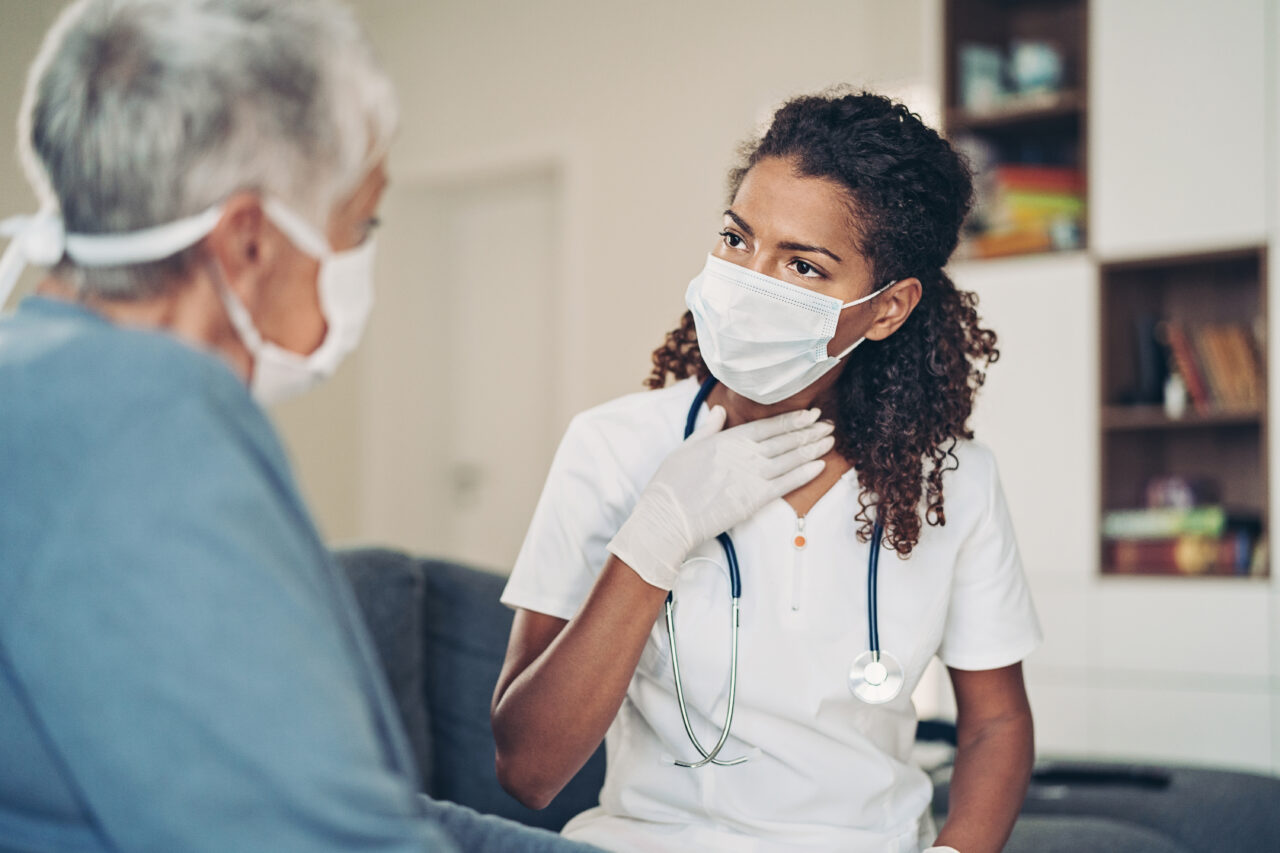
Getty Images
The COVID treatment is effective at preventing severe disease, but it has been mired in confusion after misleading reports of "Paxlovid rebound."
In mid-July 2022, President Joe Biden was diagnosed with COVID-19. Due to the president’s age, 79, he was at increased risk of hospitalization and death. So, he was prescribed the COVID-19 treatment antiviral drug Paxlovid.
Initial studies indicate that Paxlovid reduces risk of hospitalization by 89% and reduces the risk of death by 81% among those at risk for severe disease. It’s also covered by Medicaid, Medicare, and most insurance companies. Yet, Paxlovid uptake has been slow — from December until May, 831,000 doses were administered out of 3.8 million cumulative available to states from the federal government. Though there has been an uptick of Paxlovid courses administered — 5.4 million out of an available 8.3 million — there is still confusion among physicians on concerns prescribing the COVID treatment and confusion on whether to take it in the general public.
Particularly as we go into flu season, it’s vital to increase awareness and understanding about Paxlovid, ensuring patients can get home COVID treatment to reduce hospitalizations.
“Unfortunately, COVID is not over,” says Cassandra Pierre, MD, MPH, associate hospital epidemiologist at Boston Medical Center (BMC) “We expect to see our hospitalizations go up in the fall and winter and our deaths with that. Paxlovid offers a way to continue to reduce the risk for those with high medical vulnerability.”
“We expect to see our hospitalizations go up in the fall and winter and our deaths with that. Paxlovid offers a way to continue to reduce the risk for those with high medical vulnerability.”
With the emergence of new COVID variants and threats of a winter surge looming, what is stopping clinicians from prescribing Paxlovid and patients from requesting it?
“Getting more people to access Paxlovid requires both patient education and provider education,” says Jai Marathe, MD, the medical director of the Infectious Diseases clinic at BMC. “The patient education needs to be awareness of the available therapeutics like Paxlovid and the things that put them at risk for severe disease.”
As for providers, Marathe notes that they should make sure of the resources and education around them on who can get a Paxlovid prescription, the alleged “COVID rebound effect,”
Paxlovid drug interactions, and more.
Who can get a Paxlovid prescription?
A persistent issue with Paxlovid is patient confusion around eligibility. The FDA compiled a checklist for prescribers that works as a screening tool to determine who should can get a prescription for this COVID treatment. A patient must meet all three criteria:
- At least 12 years old
- Have one or more risk factors for progression to severe COVID-19
- Have symptom onset within 5 days
These are not as limiting as one might think, with one 2021 study indicating that a whopping 75% of all Americans have at least one risk factor that could increase their chances of developing severe COVID-19.
Access to at-home tests have made it easier to determine whether someone has COVID-19, but people aren’t necessarily calling their doctor to inform them of a COVID diagnosis. According to Marathe and Pierre, people may feel like they don’t need Paxlovid because their symptoms are mild at the start. Then, if they’re symptoms do escalate, it’s too late past the five-day window to start Paxlovid.
Do people even need Paxlovid if they’re vaccinated?
Another reason patients think they don’t need Paxlovid is because they have gotten a COVID-19 vaccine. But vaccines and therapeutics are two different beasts.
“The vaccine is to prevent infection from happening. Vaccines, even if you get breakthrough infections, will afford your preexisting immunity that decreases how severe the symptoms might be or how severe the infection might be,” Marathe explains. “The therapeutics on the other hand, are taken when you are already infected and have symptoms. It will stop the progression of the disease and prevent severe disease and hospitalization. Prevention versus treatment — two different arms of how to think about the infection.
Vaccinated people make up a very small percentage of individuals hospitalized for severe COVID-19. But according to Pierre and Marathe, with new variants emerging and low national booster rates, we may be seeing more vaccinated people hospitalized for COVID.
This begs the question: Should providers still prescribe Paxlovid to vaccinated patients who test positive and are symptomatic? Marathe and Pierre give a resounding yes, particularly if the patient is elderly, immunocompromised, or otherwise high risk. A recent study evaluated the effectiveness of Paxlovid in people who were vaccinated and found that people over the age of 50 who were prescribed Paxlovid were three times less likely to be hospitalized when compared to people who were not prescribed Paxlovid. What’s more is that another study (though it has not yet been peer reviewed) suggests that Paxlovid may play a role in reducing the risk of long COVID in eligible patients with a COVID infection, if they follow the five day protocol.
Is the COVID rebound effect real with Paxlovid?
Clinicians have been hesitant to prescribe the antiviral COVID treatment. Marathe and Pierre believe that one major reason is the media response, particularly around the alleged “COVID rebound effect,” in which people believe that taking Paxlovid coincides with a higher chance of getting a worse COVID-19 infection afterward. Not long after President Biden took Paxlovid for his initial infection, news broke that he again tested positive after several days of negative test results. This led to a media firestorm about the efficacy of Paxlovid.
Pierre stresses that this narrative is misleading: “Study after study has shown that whether you take Paxlovid or not, the same percentage of individuals are likely to have a rebound of symptoms after initial improvement.”
Marathe hypothesizes that because at-home rapid tests and Paxlovid became available at the same time, it created a perfect storm of opportunity.
“Because people had at-home tests readily available, they were taking Paxlovid, recovering, and then immediately retesting themselves once they started feeling symptomatic again,” Marathe explains. “It’s not that these results were wrong, it’s that other people who were experiencing the same reaction weren’t taking Paxlovid but experiencing the same symptoms. It just wasn’t getting reported.”
But, still, this notion of the “Paxlovid rebound effect” remains lodged in the collective consciousness
“Once you perpetuate a myth — whether intentionally or unintentionally — overcoming that is a challenge,” Marathe says.
Pierre agrees: “There’s been confusion for some people about why they’re taking Paxlovid. Many people think it’s for symptom improvement. This isn’t entirely true. It’s primarily to reduce the risk of severe infection that may require hospitalization. But if you do take Paxlovid, you’re going to have a heightened scrutiny over your own symptoms, and then if you get rebound you start repeating it to people, who then repeat it to other people, perpetuating the myth that this is a failure — like it didn’t work for what it was supposed to do.”
Pierre wants to stress that this is not accurate; if Paxlovid keeps someone from progressing to development of severe COVID-19 disease, out of the hospital and alive, it has done its job.
How can clinicians empower themselves to appropriately prescribe Paxlovid?
Physicians and other prescribers play a huge role in who ultimately gets a Paxlovid prescription. According to Marathe and Pierre, there are a number of things prescribers can do to ensure that everyone who needs a prescription has equal access to the antiviral.
- Check with pharmacy colleagues: Multiple medications interact with Paxlovid, which can make some physicians and other non-pharmacy prescribers hesitant about prescribing the drug. Most pharmacies — including the ambulatory pharmacy at BMC — support a medical background check to look at drug interactions.
- Understand and educate patients regarding COVID-19 rebound: Some people with COVID-19 infection can experience a recurrence of COVID-19 symptoms and/or a new positive test after initial recovery and/or a negative test. This may happen in patients regardless of whether they have been treated with Paxlovid. If this happens, CDC recommends re-isolation for at least 5 days, until the fever has resolved for more than 24 hours without use of fever-reducing medication and symptoms start improving. Rebound symptoms are usually mild and short-lasting. Fear of COVID rebound should not be a barrier to prescribing Paxlovid.
- Make a plan with your patients: When you’re meeting with patients, talk about the flu vaccine, the bivalent COVID vaccine, and also about risk factors.
“I have a few patients who fall into the high-risk category,” says Pierre. “I’ve had conversations with them where I say, ‘If you do get COVID, this is the medication I recommend for you and why, and then this is who you should call to make sure you get what you need.”
Pierre stresses that helping patients be comfortable and familiar with the process before infection is essential so they aren’t wasting valuable days deciding whether they should get Paxlovid. She says, “You want that plan in place, especially for those at highest risk for severe disease.”
- Keep abreast of national and local recommendations and guidelines: Keep abreast of Department of Public Health and CDC recommendations, and, when in doubt, reach out to infectious disease providers, who can be helpful guides in assessing unique situations and making appropriate patient-specific therapeutic recommendations. At BMC, there is information on the patient-facing website about who qualifies for therapeutics. There are various resources external to BMC available, including the state and city public health websites, and Cambridge Health Alliance (CHA)’s call line, Pierre notes is a resource to refer patients who are afraid to discuss health insurance or residency status.
It’s important to note that Paxlovid is not the only COVID-19 treatment available. There are also monoclonal antibody therapies and other antiviral medications, but the former require documentation of insurance — including for Medicaid and Medicare — which can be limiting to many patients without insurance. And those patients, as well as other more vulnerable and marginalized people, are at high risk for not just COVID-19, but for misinformation.
“I find that misinformation crosses socioeconomic boundaries,” says Pierre. “But people who are structurally vulnerable are already less likely to have access to a trusted messenger. A lot of people are concerned, especially they’re uninsured or undocumented on accessing therapeutics and resources that might lead to issues around billing or residency status.”
It’s up to all providers to empower themselves to be those sources of trusted information.


